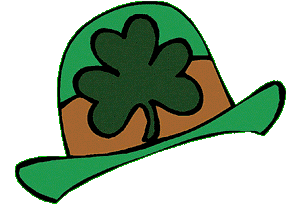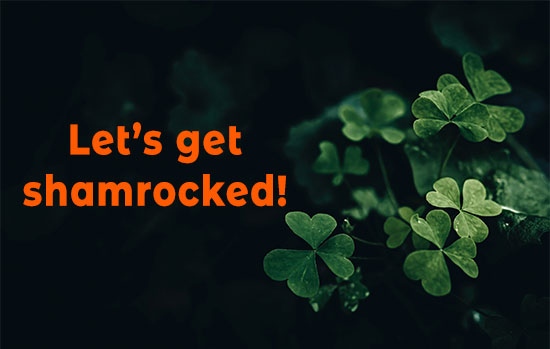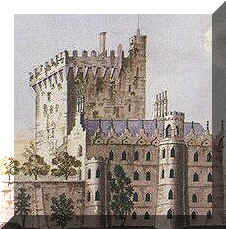A world-famous symbol of Ireland, many people may not know why the shamrock is associated with Ireland. Dress up in green, try to catch a leprechaun, search for a pot of gold at the edge of the rainbow and celebrate all things Irish. Even if you're not Irish.
Welcome to the tidbits page of Patty's day. Here you will find interesting notes on Shamrock, Blarney's Stone, and of course, the Leprechaun. There are options too, to send a free greetings for patty's day. Please refer our site to your friends. Happy Patty's Day!
In written English, the first reference to the Shamrock dates from 1571, andin written Irish, as seamrog, from 1707. As a badge to be worn on the lapel on the Saint's feast day, it is referred to for the first time as late as 1681. The Shamrock was used as an emblem by the Irish Volunteers in the era of Grattan's Parliament in the 1770's, before '98 and The Act of Union. So rebellious did the wearing of the Shamrock eventually appear, that in Queen Victoria's time Irish regiments were forbidden to display it. At that time it became the custom for civilians to wear a little paper cross colored red and green.
As a symbol of Ireland it has long been integrated into the symbol of the United Kingdom, along with the Rose, the Thistle and the Leek of England, Scotland and Wales. So today, on St. Patrick's Day, a member of the British Royal Family presents Shamrock to the Irish Guards regiment of the British Army.
Click Here to send a Shamrock card!
Shamrock is a type of three-leafed clover that is commonly associated with Ireland and Irish culture. St. Patrick's Day is a cultural and religious holiday celebrated annually on March 17th in honor of St. Patrick, the patron saint of Ireland.

The shamrock is often used as a symbol of St. Patrick's Day and of Irish identity in general. According to legend, St. Patrick used the shamrock to explain the concept of the Holy Trinity to the people of Ireland during his mission to convert them to Christianity. Today, the shamrock is widely recognized as a symbol of good luck, and is often worn or displayed on St. Patrick's Day.
Leprechauns are mythical creatures from Irish folklore. They are typically depicted as small, mischievous creatures who are often associated with good luck and gold. In popular culture, leprechauns have become closely associated with St. Patrick's Day, and are often portrayed as symbols of Irish culture and heritage.
In modern times, leprechauns are often depicted wearing green clothing, a top hat, and buckled shoes. They are often shown carrying a pot of gold at the end of a rainbow, which is said to be their most prized possession. It is also said that if you catch a leprechaun, he must grant you three wishes in exchange for his release.
While leprechauns are not directly related to St. Patrick's Day in terms of their historical or religious significance, they have become a popular and recognizable symbol of the holiday, especially in the United States. You may see leprechaun-themed decorations and costumes, and some people even set up elaborate traps in an attempt to catch a leprechaun and claim their pot of gold.
Near a misty stream in Ireland in the hollow of a tree
Live mystical, magical leprechauns
who are clever as can be
With their pointed ears, and turned up toes and little coats of green
The leprechauns busily make their shoes and try hard not to be seen.
Only those who really believe have seen these little elves
And if we are all believers
We can surely see for ourselves.
(Irish Blessing)
 Click Here to send a Pot-o-gold card!
Click Here to send a Pot-o-gold card!
Blarney Stone is a famous tourist attraction located in the grounds of Blarney Castle in County Cork, Ireland. According to legend, anyone who kisses the Blarney Stone will be given the gift of eloquence or "the gift of the gab", which means the ability to speak in a persuasive and charming way. The stone is said to have been a favorite of many famous historical figures, including Winston Churchill and American author Mark Twain.
While the Blarney Stone is not directly related to St. Patrick's Day in terms of its historical or religious significance, it has become a popular destination for visitors to Ireland and is often associated with Irish culture and heritage. Many people visit Blarney Castle and kiss the stone as a way to connect with their Irish roots or to bring good luck to their lives. It is also a popular destination for tourists during St. Patrick's Day celebrations, which are often held across Ireland and around the world.
St. Patrick's Day is primarily a celebration of Irish culture and heritage, and it is typically marked with parades, music, dance, and other festivities. While the Blarney Stone is not directly related to these celebrations, it is a well-known symbol of Ireland and has become a popular attraction for visitors to the country who are looking to experience its rich cultural history.
Click Here to send a Blarney Stone card!
